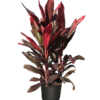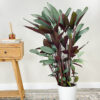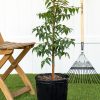Description
Dress Up Your Garden with Exuberant ColorThe Cordyline Fruiticosa (Cordyline Florida) belongs to the Dracaena family of plants. It is native to warmer climates of Pacific islands, including eastern Australia, Southeast Asia, and Hawaii. It is also known as the Hawaiian Ti plant for that reason. The plant is ideal for hardiness zones with temperatures generally above 55°F. Although it is native to warm tropical climates, Cordyline thrives pretty well as a houseplant. It features sword-shaped colorful leaves, resembling the foliage of a palm tree. Also known as Florida Reds, these plants produce small florets and berry-like fruits in the spring. Many plant parents grow the Ti plant as a landscape specimen, while others prefer it as a potted houseplant. It is a popular choice among gardeners for its attractive and fast-growing foliage.Caring for your Ti PlantThe Cordyline Florida is an excellent plant for beginner plant parents. If you follow the care instructions correctly, this houseplant will not give you much trouble. Let us see how to take the best care of this popular garden plant.LightAlthough Ti Plant’s light requirements may seem tricky initially, you will quickly get the hang of it. Sun exposure helps improve the color of the plant’s foliage. However, excessive direct sunlight can also harm the leaves, causing them to turn brown at the tips and margins.It is a full-sun plant, meaning it needs at least six hours of sunlight daily. Having said that, if you’re growing a Cordyline Florida outside, you must do so in a shaded place to protect it from direct sunlight. SoilCordyline houseplants thrive well in well-draining soils high in organic matter. Additionally, they prefer slight acidity to produce beautiful and healthy leaves and maintain foliage. Loamy and sandy soil varieties are ideal. You should avoid wet/ hard potting clay and garden sites with salt spray. WaterTi Plants typically experience daily pouring in their native habitat. Simply put, they prefer regular watering to mimic their natural growing environment. Watering your Cordyline Florida a couple of times every week is acceptable during the growing season.Ti plants require damp but saturated growing conditions in indoor gardens. Ideally, you want to ensure the soil remains moist but not wet. Heavily dampened soil can cause root rot, so you want to avoid overwatering at all costs. FertilizerWhen it comes to feeding a Ti Plant, applying too much fertilizer can harm plants more than benefit their health. Slow-release fertilizers with balanced amounts of potassium, nitrogen, and phosphorus work best for outdoor Cordylines. Feed your plant once in spring, its growing season, by spreading the fertilizer evenly around the soil and watering it right after. Common IssuesLike all houseplants, Cordyline Florida plants are susceptible to certain pests and diseases. Carefully following the care instructions can help maintain your plant’s health and beauty. PestsMites, scales, mealybugs, thrips, and fungus gnats are the most common pests that affect Ti Plants. You should regularly wipe the leaves with a clean and damp cloth to prevent the pests from attacking your plants. You can also use pesticides in the soil to control scales, mealybugs, and gnats, whereas spraying the foliage is best for controlling mites.DiseasesCordyline Florida plants are susceptible to various fungal diseases. Furthermore, the disease risk increases in moist growing conditions or overcrowded landscapes. To avoid fungal infections, water your plant at the ground level instead of overhead watering and dust a fungicide powder.PruningAs the plant matures, older leaves tend to die out. Pruning Ti plants are essential for removing dead and damaged leaves that can worsen diseases and attract pests. You want to keep removing yellowing leaves as they appear to control your Cordyline’s shape and size. Prune your plants once a year during their growing season. PropagationTi plants are low-maintenance and beginner-friendly houseplants and extremely easy to propagate. As a plant parent, you can choose from various propagation methods, such as sowing seeds, division, layering, and placing the cuttings in water. If you are new to gardening, rooting short cane sections is ideal.Potting/ RepottingPotting/ repotting a Cordyline Florida is easy, given you are gentle and follow the correct methods. Few of the most important things that make the most significant differences include finding a suitable pot and potting soil. Ideally, you want well-draining soil and a container with several drainage holes. Make sure your new pot is larger than the previous one n size.





